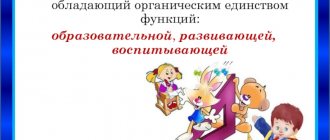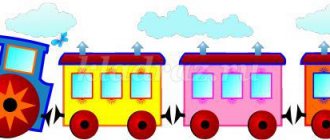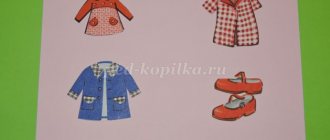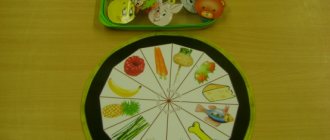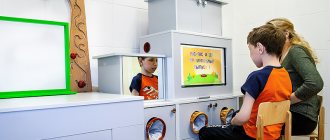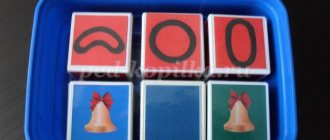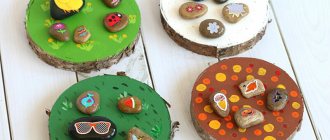Outdoor games
- Game "Who's Dressed in What." This game requires several participants. The presenter says: “Whoever is wearing a red T-shirt, sit down,” or “Whoever is wearing green pants, clap your hands.” The player whose color is named must perform the given actions.
- Round dance . The children dance in a circle, the adult says:
“Masha walked along the path, Masha found slippers. Masha tried on the slippers, put them on a little, and limped. Masha began to choose who to give the slippers to. Kolya’s slippers are good: “Here, put them on and dance.”
The shoes are given to the person whose name is named.
- Paths . We put several scarves on the floor - these were our paths. And they ran and jumped on them. We found a short-long path, wide-narrow.
Home clothes
Take clothes out of your closet. Lay it out in front of your child. Introduce your baby to the names: collar, sleeve, sleeves, pocket, pockets, button, buttons, zipper, hood. Tell your little one that there are outerwear and underwear. The upper one is so called because we wear it on top, the lower one – below, under clothes. Look at the pictures on the clothes, talk about what they are made of. Name the color of the clothes at the same time, count the sleeves, pockets, buttons. Tell your child what seasonal clothing is. Let him guess what time of year these clothes are worn (hat, jacket - in winter, cap, T-shirt - in summer).
Game "Suits"
Draw separately the details of the costume: blouses and skirts, T-shirts and shorts, jacket and trousers. The main thing is that the details of the costume are the same color, pattern, etc. (T-shirt with red polka dots and shorts are the same). Mix all the details. Ask your child to choose the right costumes. Start with 2-3 and gradually increase complexity.
Game "Find a Pair"
Get out the different shoes you have in your house. Lay them out on the floor and ask your child to find the pairs. If your child easily copes with the task, sort the shoes - with laces, with a lock, with a buckle, etc.
Another version of the game is to lay out the socks in front of the baby and invite him to find the pairs. A little later, add mom’s socks, let the child not only sort them into pairs, but also separate the small ones from the large ones.
Talk to your child about what else comes in pairs: arms, legs, ears, glasses, etc.
Task 7. Learning to speak without mistakes - the words “put on” and “dress”. Let's play and remember!
A common speech error among children is the incorrect use of the words “dress” and “put on.” The rule here is: “DRESS” we say if we dress someone (we dress our son for a walk, we dress a doll, a bear, a baby, a sick person). We always wear something - a coat, a raincoat. And “put on” is said when we “put on” ON ourselves - on our hands, on our feet. Therefore, it would be correct to say “put on trousers (for myself)”, but “put on a doll for a walk”.
There is no need to remember this rule. You just need to play speech games with your child, and he will easily and playfully remember it and will no longer make mistakes. And of course, in everyday communication you need to monitor the correct use of these words (example for comparison: “Have you already put on a sweater? Well done!” “Have you already put on a bear? Great! Then the bear can go for a walk with us”)
Let's start playing!
Read a fragment from a poem by Elena Blaginina to your child.
Mom hummed a song, dressed her daughter. Dressed - put on a white shirt. White shirt, thin stitching...
Mom finished the song, Mom dressed the girl. Red dress with polka dots, New shoes on the feet. This is how my mother pleased me - she dressed up her daughter for May. This is the kind of mother she is - truly golden!
Who did mom dress? How did she dress her daughter?
A game with the word "dress".
Invite your child to play. It will be as if you are DRESSING a bear or a bunny for a walk (demonstrate these actions with gestures), and the baby will need to guess from your gestures what you are DRESSING the toy with. For example, show that you are wearing a sweater (there is no sweater, just showing with gestures) and ask: “What am I dressing Mishka in?” Or show that you are dressing Mishka in trousers and ask, “Now what did I dress him in?” You can show with a gesture how you put Mishka in a shirt and fasten the buttons on the sleeves. Then let the baby ask similar riddles for you. The word “dress” will always be used in this game, and the more often the better! “What did I dress the bear in?” - “Are you wearing a teddy bear in your jacket?” - “No, I didn’t put him in a jacket. I dressed him in something different, but similar to a jacket. Well, can you guess it?” - “Did you dress him in a coat?” etc. Repeated natural repetition of a word in a game will be remembered by the child, and he will not make mistakes.
This little rhyme for kids will help you remember better how to use the word “dress.”
A play on the word “put on.”
When the child in the first game always names the action correctly (“dress” a doll, a bear, a bunny - what? put on a fur coat, a coat, a dress, shorts), you can move on to the second game - with the word “put on”.
Show how you put something on yourself, and the baby guesses what action you showed - “Mom, did you put on your coat?” - “No, not a coat. And here’s what... (in a mysterious voice and repeat the gesture).” - “Are you wearing a fur coat? - “No, not a fur coat. I didn't wear a fur coat. I put on completely different clothes (we repeat the gesture again),” etc. Then we change roles - the child shows what kind of item of clothing he is wearing (tells us a riddle). And we guess.
Some children do not want to show with a gesture, but actually start putting on clothes in this game. Let them put it on! It won't hurt at all! And it will even add intrigue. Stand with your back to the child, close your eyes (you can blindfold yourself with a handkerchief) and begin to guess what your baby is putting on at this moment in time: “Are you wearing tights? No? Then are you wearing shorts? Also no. Mmmmm. Maybe you're wearing overalls? etc. The natural richness of this game with the word “put on” and the child’s interest in the game lead to the fact that this word and the situation of its correct use are remembered very simply and quickly. And in the future, the child will not have any problems with the correct use of the words “dress” and “put on”! And there will be no need for boring repetitions of these words in exercises, because in life everything is remembered naturally, easily and simply!
Logic games:
- Separate the mittens from the gloves.
- We sort clothes according to the principle: large, small, medium (we select trousers for the doll from three options).
- We sort according to the principle: long, medium, short (scarf).
- Game "What's extra?" — (jacket, skirt, sweater and scissors).
- Game "Continue the Row"
- Game “Connecters” (we draw pairs of clothes, the child’s task is to connect the same ones with each other).
- Puzzles – draw clothes, cut them into 3-4 pieces and you’re done.
- We count the number of things in the bags (we draw several bags, “fill” each one, invite the child to put the numbers into the bags).
- We are looking for shades for clothes.
- Game "Singular and Plural". Call the child the object in the singular, and he in the plural. For example: shoe - boots.
- Game "What's missing?" Place clothes or shoes in front of the baby. Take one away - what's missing? Another option is to swap shoes - what has changed?
- Game "What's Hidden" Take several hats and hide any object or toy under one of them. Let the baby try to guess where she is.
Progress of the lesson:
Surprise moment "What's in the chest?"
Children are asked to open the chest and see what is in it. (One piece of shoes from a pair according to the number of children).
What do you think this is? How to call it in one word? Shoes.
Didactic game “Pick a Pair”
Here you have doll shoes in your hands. (One item per pair).
Only the confused doll scattered all the shoes, you need to find a pair. Count it. How many legs does the doll have? Two legs. This means there should be two shoes. Here you have it. Like a doll, it also has two legs. How many slippers do you have on your feet? Two slippers. And you came here wearing two boots. When there are two of something, they say “pair”. Remember this word and repeat it out loud: “couple.” Now go in search of a pair for the shoes you have in your hands.
Didactic game “The colorful locomotive brought a lot of shoes”
Pick up a pair of each shoe and place them in colored trailers: yellow shoes in a yellow trailer, red shoes in a red trailer, green shoes in a green trailer, and blue shoes in a blue trailer.
Didactic game “Patches for boots”
But this boot has holes. Select suitable patches for each hole.
Game with buttons “Decorate the boot”
But this boot needs to be decorated with multi-colored buttons. Look carefully. Whatever color and size the circle on the boot is, apply the same button to it. Place a large blue button on the large blue circle. And on the small yellow circle, place a small yellow button on top.
Application “Beautiful boots”
Look, your boots are waiting for you to make them beautiful, decorate them with funny pictures. Select a picture. Which you will decorate the boot with. Some will decorate it with flowers, and others with fish.
Dynamic pause “Big feet are walking along the road”
Big feet are walking along the road, stomping, stomping, stomping, stomping. (Walking with long strides)
Little feet run along the path, Top-top-top-top-top, Top-top-top-top-top. (Running in small steps)
Didactic game “Pick shoes for three bears”
And here are our familiar bears. Show the biggest bear, the smallest, the medium bear. You have already selected barrels of honey for them, and now you need to help the bears choose shoes that fit and put them on their paws. Put the biggest boots on the biggest bear, medium boots on the middle bear, and the smallest boots on the smallest bear.
Didactic game “Find the extra object”
There are pictures in front of you. Name what is drawn on them. What is it that isn’t shoes, that they don’t put on their feet? Mittens.
Exercise “Washing shoes”
To wear shoes for a long time, you need to take care of them, wash them and clean them from dirt. Now we will take wet sponges and wipe the dirt off our shoes.
Game with paper clips “Hemming slippers”
When shoes are worn for a long time, it happens that the sole of the shoe comes off. Then the sole is hemmed. Now try putting paper clips on the edges of the slipper, as if you were hemming the sole.
Children are invited to paint the shoe.
Didactic game “Find the shadow”
Place a matching colored shoe on top of each shadow.
Modeling “Shoes for a centipede”
Roll balls out of plasticine, attach them to the centipede's leg and press with your finger - you get shoes for the centipede.
Musical break "Centipede"
Children line up one after another, put their hands on each other’s shoulders and move to the music as directed by an adult.
Reading the poem "Boots"
Dimka’s mother bought them Excellent boots. Beautiful, shiny! Leather! Real!
I looked at them for a long time. He put them on the shelf. Beautiful, shiny! The laces are real!
When the baby went to bed, he put the shoes under the bed. New, shiny! Leather! Real!
Lacing game “Lace up your shoes”
Children are asked to insert the laces into the holes and tie them.
Game with clothespins “Shoe brush”
This is a shoe brush for polishing shoes. Try making your own brushes. This is how you need to attach clothespins to make a shoe brush.
- Here is a game for preschool children, with the help of which kids will be able to master spatial concepts, learn how to use prepositions correctly, and develop visual perception and voluntary attention. There are 72 cards in the manual.
An educational game for preschool children, with the help of which kids will be able to repeat the names of animals and their cubs, as well as develop attention, memory and speech. Before starting the game, cut the cards along the dotted lines, you will get 72 cards (9x10 cm). Give the children an equal share of cards with images of adult animals. Then show cards with pictures of cubs one by one. Pay attention to whether the child correctly names the cubs in singular and plural.
A lotto game to develop children's knowledge about what clothes are worn at what time of year. Children consolidate previously acquired knowledge about the seasons and are already well versed in what clothes are suitable for a particular season. The game contains 12 cards + 4 lotto cards. Each card features a boy or girl dressed for each season - three pictures for each season. You can also complicate the task by arranging the cards not only by seasons, but also by months.
Introducing children to the lexical topic "Professions". The child must choose a picture that matches the meaning. 1.Print the sheets on A4 format. 2. Cut out the pictures along the contours. 3. Fold together. 4. Secure them with a stapler or string. 5. Cut along the dotted lines. 4 jpg / 300 dpi / A4 / 5.42 MB Compiled by: fantastisch
Zhelevskaya Oksana Nikolaevna
Description of work:
I bring to your attention didactic games and exercises on the lexical topics “Clothes”, “Shoes”, “Hats”. The games are intended for children of older preschool age. During the games, children practice word formation and inflection in an entertaining way. Games can be used for individual and subgroup work. This material will be useful to speech therapists of preschool institutions, educators, as well as parents when playing the game at home.
Target:
consolidation of acquired knowledge in classes in an entertaining game form.
Tasks:
— test children’s knowledge, skills and abilities on the topic; - learn to apply them in practical activities - games; - cultivate interest in speech games.
The game “Whose clothes are Mom’s or Tanya’s?”
Target:
practice forming possessive adjectives.
Game material.
- pictures with items of adult and children's clothing and shoes
Pictures of two closets: A closet for mom’s clothes and a closet for Tanya’s clothes.
Progress of the game:
An adult puts pictures of wardrobes, pictures of clothing and shoes on the board. Children come to the board, choose a picture, tell whose item of clothing it is and put it in the closets.
— This is my mother’s long dress. — This is Tanino’s blue dress. - This pink blouse is Tannin's. — This white blouse is my mother’s. — These black trousers are my mother's. — These lilac trousers are Tanina. - This fluffy skirt of Tanin. — This tight skirt is my mother’s, etc.
Game "Pick the sign"
Target:
practice selecting adjectives for nouns.
Progress of the game:
The child names an item of clothing, and then selects attributes for this item of clothing,
for example, a dress - beautiful, long, evening, elegant.
The child must select at least 3 signs.
Game “Name it kindly”
Target:
to train children in the formation of nouns with diminutive suffixes –chik-, -echk-,- ochk-, -enk-, -onk-.
Progress of the game:
An adult calls an item of mother’s clothing or shoes, and the child calls it Tanya, and calls it affectionately,
for example,
“Mom has a dress, and Tanya has ...
a dress
.”
- Mom has shoes, and Tanya has... shoes.
- Mom has trousers, and Tanya has...
trousers.
- Mom has a jacket, and Tanya has...
a jacket
.
Game "What is what?"
Target:
practice forming relative adjectives.
Progress of the game:
An adult says: “Mom and Tanya have a lot of clothes.”
It is sewn from different fabrics. Let's tell you what items of clothing are made of and what they are. - Dress made of silk (what kind?)
- silk.
- Wool jacket (what kind?)
- wool.
— Boots made of leather (what kind?)
– leather.
- Boots made of rubber (what kind?)
- rubber.
- Coat made of drape (what kind?)
- drape.
- Corduroy trousers (what kind?)
- corduroy.
Game "One - Many"
Target:
developing the skill of forming noun forms in the genitive plural.
Progress of the game:
The child is asked to name an item of clothing with the word many,
for example,
“Mom has one dress, but Tanya
has many dresses
.”
“Mom has one skirt, and Tanya has many skirts...
The game “Two - two””
Target:
practice the ability to coordinate the numerals two, two with nouns.
Progress of the game:
The adult invites the child to answer the questions: - What can you say two things about?
- Two dresses, two coats, two raincoats...
- What can we say two about?
— Two T-shirts, two fur coats, two jackets, two skirts, two sweaters...
Game “Count and Name”
Target:
practice agreeing numerals with nouns.
Progress of the game:
An adult shows a card depicting items of clothing, shoes, hats and invites the child to help Tanya count things.
For example,
One hat, two hats, three hats, four hats, five hats.
One jacket, two jackets... five jackets. One pair of boots, two pairs of boots, three pairs of boots... six pairs of boots. Game "Say the other way around"
Target:
Exercise children in selecting words that have opposite meanings (antonyms).
Progress of the game.
The adult invites the child to answer the other way around: Clean shoes - ...
dirty shoes;
New boots - ...
old boots;
Wide skirt - ...
narrow skirt;
Long coat - ...
short coat;
White jacket -...
black jacket.
Game "Put it into pieces"
Target:
practice classifying items of clothing, shoes and hats.
Progress of the game.
An adult shows a picture of a closet with shelves and says: “Look - this is a closet.” Each item in it has its own place: hats are stored on the top shelf, shoes on the bottom, and clothes on the middle. Let's put the pictures depicting various items of clothing, shoes and hats in their places.
Children lay out the pictures and explain: - I will put the hat on the top shelf, because it is a headdress; - I’ll put the jacket on the middle shelf, because it’s clothes; — I’ll put the slippers on the bottom shelf, because these are shoes….
Game "Mine, mine, mine"
Target:
practice agreeing nouns with possessive pronouns my, mine, mine, mine.
How to play:
An adult lays out items of clothing and shoes on the table.
Invites the child to look at them carefully and say to which object the word “mine”, “mine”, “mine”, “mine” is suitable. My (what?)
- sweater, sundress, scarf, suit... My
(what?)
- jacket, sweater, fur coat, skirt... My
(what?)
- boots, shoes, shorts, trousers... My
(what?)
- dress, coat…
Game "Four Wheel"
Target:
activate children's vocabulary on the topic, develop mental activity and attention.
Progress of the game.
The adult shows the child the pictures, asks them to name them, indicate the extra picture in each row and explain why it is extra.
I wish you success!
Expand children's knowledge about clothing and its functions
Enrich children's vocabulary on the topic
Learn to classify clothes according to a given criterion (men's - women's, summer - winter)
Develop thinking, attention, memory, fine motor skills
